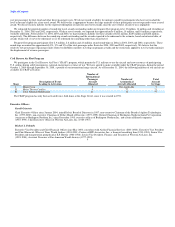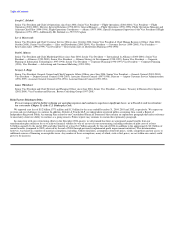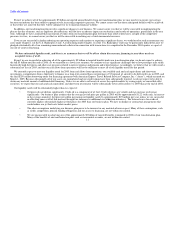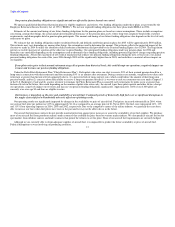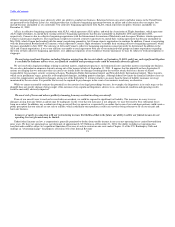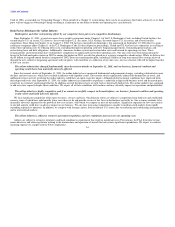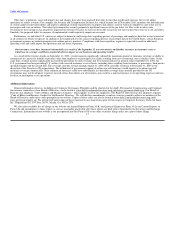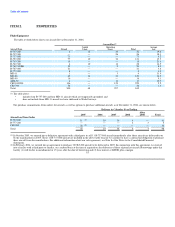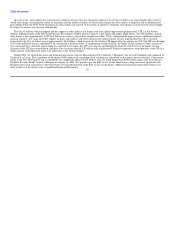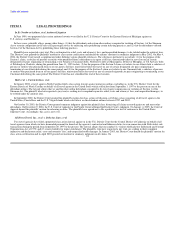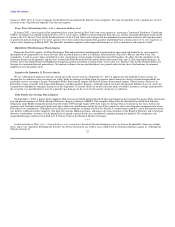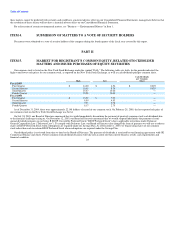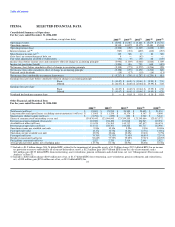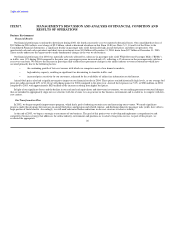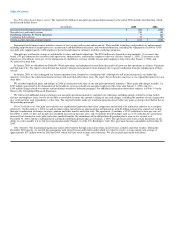Delta Airlines 2004 Annual Report Download - page 23
Download and view the complete annual report
Please find page 23 of the 2004 Delta Airlines annual report below. You can navigate through the pages in the report by either clicking on the pages listed below, or by using the keyword search tool below to find specific information within the annual report.
Table of Contents
Delivery in Calendar Year Ending
After Rolling
2005 2006 2007 2008 2008 Total Options
Aircraft on Option(1)
B-737-800 — — — 12 48 60 168
B-767-300/300ER — 1 2 2 5 10 6
B-767-400 — 1 2 2 17 22 —
B-777-200 — — — 1 19 20 5
CRJ-200 — 52 33 21 20 126 —
CRJ-700(2) — 22 31 31 40 124 —
Total — 76 68 69 149 362 179
(1) Aircraft options have scheduled delivery slots, while rolling options replace options and are assigned delivery slots as options expire or are exercised.
(2) Our collective bargaining agreement with ALPA limits the number of jet aircraft certificated for operation with between 51 and 70 seats that may be
operated by other U.S. carriers (including ASA and Comair) using the Delta flight code. This limit is currently 82 aircraft, increasing to 106 aircraft in
2006, and 125 aircraft in 2007 and thereafter. These limits may increase in the future depending on the scheduled block hours flown by Delta pilots.
Our long-term agreement with The Boeing Company ("Boeing") covers firm orders, options and rolling options for certain aircraft through calendar year
2017. This agreement supports our plan for disciplined growth, aircraft rationalization and fleet replacement. It also gives us certain flexibility to adjust
scheduled aircraft deliveries and to substitute between aircraft models and aircraft types. The majority of the aircraft under firm order from Boeing will be
used to replace older aircraft.
Our plan is to reduce Mainline aircraft fleet complexity by up to four fleet types over approximately the next four years. We believe fleet simplification
will improve reliability and produce long-term cost savings. During 2005, we expect to retire 24 Mainline aircraft: 21 B-737-300 and B-737-200 aircraft, and
three B-767-200 aircraft. These retirements will not have a material impact on our 2005 Consolidated Financial Statements. Due to weak traffic, we
temporarily grounded the entire MD-11 fleet by the end of January 2004 and sold eight owned MD-11 aircraft in October 2004. As a result of these actions, in
2004, we operated a Mainline fleet composed entirely of two-pilot, two-engine aircraft.
Our regional jet operations offer service to small and medium-sized cities and enable us to supplement Mainline frequencies and service to larger cities.
As of December 31, 2004, ASA had returned two ATR-72 turbo prop aircraft to the lessor upon lease expiration. ASA continues to operate the remaining
ATR-72 turbo prop aircraft, while Comair operates an all-jet fleet.
Ground Facilities
We lease most of the land and buildings that we occupy. Our largest aircraft maintenance base, various computer, cargo, flight kitchen and training
facilities and most of our principal offices are located at or near the Atlanta Airport, on land leased from the City of Atlanta generally under long-term leases.
We own a portion of our principal offices, our Atlanta reservations center and other real property in Atlanta.
We lease ticket counter and other terminal space, operating areas and air cargo facilities in most of the airports that we serve. These leases generally run
for periods of less than one year to thirty years or more, and often contain provisions for periodic adjustments of lease rates. At most airports that we serve, we
have entered into use agreements which provide for the non-exclusive use of runways, taxiways, and other facilities; landing fees under these agreements
normally are based on the number of landings and weight of aircraft. We also lease aircraft maintenance facilities at certain airports; these leases generally
require us to pay the cost of providing, operating and maintaining such facilities. In addition to our Atlanta maintenance base, our other major aircraft
maintenance facilities are located at Cincinnati/Northern Kentucky International Airport, Tampa International Airport and Salt Lake City International
Airport. We lease marketing, ticket and reservations offices in certain locations; these leases are generally for shorter terms than the airport leases. Additional
information relating to our leases of our ground facilities is set forth in Note 7 of the Notes to the Consolidated Financial Statements.
19


